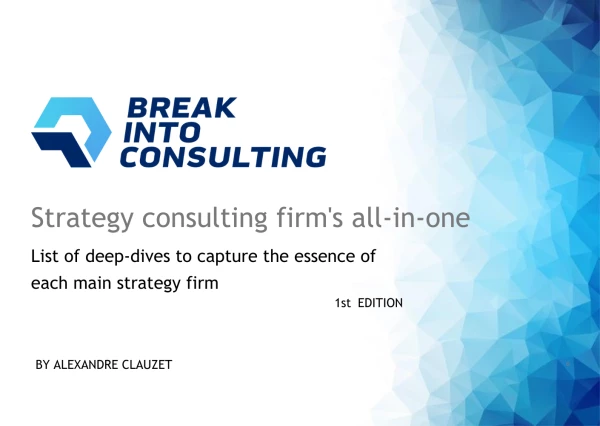Hi,
I keep recieving conflicting messages from recruiters and fellow candidates on the way I structure my approaches.
Some state that you should go at least 3 levels, and know exactly and specifically what you are asking for. But on the other hand, in case those specific points were irrelevant, you'll lose the case !
Others state that you want to have high level buckets, and make it more of a natural discussion to reach to your questions about specific data points. Personally, I'm not sure if this sounds appealing to any recruiter.
Also, another point is how many buckets you might look into analyzing. Ideally, how many buckets should we have ? Because technically you can have 4-5 MECE buckets that ARE relevant to the case. Yet, the level of relevance varies. So should one include them all for safety ? or should someone only focus on the extremely relevant buckets.
How would you advise on finding the sweet spot between general vs detailed info, and whether to include multiple buckets, or stick to a max of 3 ?
Best,
Structuring the Approach


Hi,
The answer is - both are correct since it really depends on the case:
- For some cases like profitability, I might have a structure with 3 levels (especially if I have multiple revenue streams) structured as an issue tree
- For other cases like Market related cases (market entry, new product, PE deal) I will have just 2 levels (buckets + bullet points under the buckets)
- For some cases like cost cutting or logistics I may have just 1 level (cost cutting framework (https://www.preplounge.com/en/consulting-forum/operations-cases-mck-1105#a2134) or Value chain)
Same with the number of buckets. If it is an issue tree - you may have 2-4 buckets in the first level, with market-related cases it will be 3-4 buckets, value chain 3-6 buckets, etc
So I recommend you to use a flexible approach depending on the type of the case. It definitely comes with practice. Here is an algorithm how to develop this skill:
- Make sure you understand all the different types of cases that you may face
- Identify the most appropriate structure for each type
- Solve 30-50 cases and try to understand where do they fit in your categorizations
- Based on your experience think of the potential variations in structures within each of the case types
Here is some inspiration for you. Below you can find a list of the most common case types and some high-level recommendations on structuring:
- Market sizing - structuring from the supply or demand side. Structuring using a formula or using an issue tree
- Profitability - basic profitability framework. Remember about different revenue streams and product mix
- Market context cases (Market Entry, New product, Acquisition, etc). Always start with the big picture "market". Finish with something specific to the case (e.g. How to enter?"). Structure it as if you are defining the work streams for the real project.
- Operational math problem (e.g. Should we increase the speed of an elevator or just buy a second one? How should we reduce the queues? Etc.) - Structuring as a process / value chain, with inflows, operations, and outflows
- Cost cutting - I provided the recommendations on structuring it here: https://www.preplounge.com/en/consulting-forum/operations-cases-mck-1105#a2134
- Valuation - Purely financial structure with cash flows, growth rate, WACC / hurdle rate, etc.
- Synergies - revenue synergies (price, qty, mix) and cost synergies (value chain).
- Social / economics cases (e.g. How to improve the quality of life in the city? How to increase the revenues of the museum?) - huge variability. Practice 3-5 social cases before the interview
This is just for inspiration. You should ideally make your own system.
Best of luck!
Hi!
I agree with Vlad. Let me just add 3 more things.
1. Number of level 1 buckets: 3-5 buckets is a good number. I would not make it more than 6 because then your buckets are probably already too detailed. You can always add an "other" bucket where you put all the less relevant and minor stuff in it. (just explain what it is).
2. Relevance of buckets: Some buckets might be more relevant than the others for a specific case. As a consultant you always work hypotheses driven; so try to use an 80:20 approach. You don't need to know every little detail to solve the case. Understand the key facts and KPIs first and then dig deeper where you think the solution/issue lies. In other words, focus on the most important buckets.
3. Level of detail: If you don't have the second level on paper, you should have it in your head at least mapped out; maybe even voice over it so that the interviewer knows how you think about it.
At the end what counts is that your thought process is structured and clear and that you can explain it in a clear way to your interviewer.
No worries, all comes with practice :-)
Good luck for your interview!
Best, E

Hi Ghali,
I agree with Vlad on the fact that the number of buckets and levels will depend by the framework. In general most of the structures will have:
- 3-4 buckets
- 2-3 levels
The best way to learn quickly about specific type of cases is the following:
- On your own: download MBA handbooks and filter them for the type of case you would like to improve (M&A, pricing, market entry, etc)
- With peers/expert: identify strong peers/experts with knowledge of different structures and practice with them
Hope this helps,
Francesco















